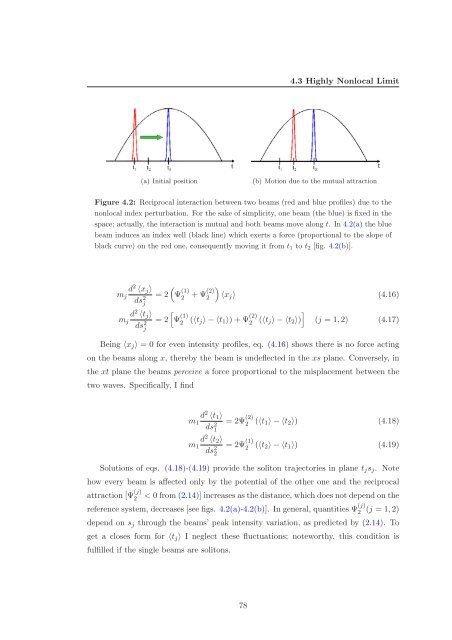Solitons in Nonlocal Media
Solitons in Nonlocal Media
Solitons in Nonlocal Media
You also want an ePaper? Increase the reach of your titles
YUMPU automatically turns print PDFs into web optimized ePapers that Google loves.
4.3 Highly <strong>Nonlocal</strong> Limit<br />
(a) Initial position (b) Motion due to the mutual attraction<br />
Figure 4.2: Reciprocal <strong>in</strong>teraction between two beams (red and blue profiles) due to the<br />
nonlocal <strong>in</strong>dex perturbation. For the sake of simplicity, one beam (the blue) is fixed <strong>in</strong> the<br />
space; actually, the <strong>in</strong>teraction is mutual and both beams move along t. In 4.2(a) the blue<br />
beam <strong>in</strong>duces an <strong>in</strong>dex well (black l<strong>in</strong>e) which exerts a force (proportional to the slope of<br />
black curve) on the red one, consequently mov<strong>in</strong>g it from t1 to t2 [fig. 4.2(b)].<br />
d<br />
mj<br />
2 〈xj〉<br />
ds2 <br />
= 2 Ψ<br />
j<br />
(1)<br />
2<br />
d<br />
mj<br />
2 〈tj〉<br />
ds2 = 2<br />
j<br />
<br />
+ Ψ(2) 2 〈xj〉 (4.16)<br />
<br />
Ψ (1)<br />
2 (〈tj〉 − 〈t1〉) + Ψ (2)<br />
<br />
2 (〈tj〉 − 〈t2〉)<br />
(j = 1, 2) (4.17)<br />
Be<strong>in</strong>g 〈xj〉 = 0 for even <strong>in</strong>tensity profiles, eq. (4.16) shows there is no force act<strong>in</strong>g<br />
on the beams along x, thereby the beam is undeflected <strong>in</strong> the xs plane. Conversely, <strong>in</strong><br />
the xt plane the beams perceive a force proportional to the misplacement between the<br />
two waves. Specifically, I f<strong>in</strong>d<br />
d<br />
m1<br />
2 〈t1〉<br />
ds2 = 2Ψ<br />
1<br />
(2)<br />
2 (〈t1〉 − 〈t2〉) (4.18)<br />
d<br />
m1<br />
2 〈t2〉<br />
ds2 = 2Ψ<br />
2<br />
(1)<br />
2 (〈t2〉 − 〈t1〉) (4.19)<br />
Solutions of eqs. (4.18)-(4.19) provide the soliton trajectories <strong>in</strong> plane tjsj. Note<br />
how every beam is affected only by the potential of the other one and the reciprocal<br />
attraction [Ψ (j)<br />
2 < 0 from (2.14)] <strong>in</strong>creases as the distance, which does not depend on the<br />
reference system, decreases [see figs. 4.2(a)-4.2(b)]. In general, quantities Ψ (j)<br />
2 (j = 1, 2)<br />
depend on sj through the beams’ peak <strong>in</strong>tensity variation, as predicted by (2.14). To<br />
get a closes form for 〈tj〉 I neglect these fluctuations; noteworthy, this condition is<br />
fulfilled if the s<strong>in</strong>gle beams are solitons.<br />
78
















